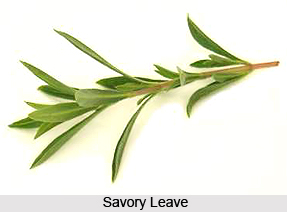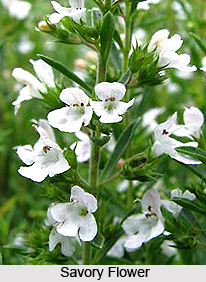 Botanical name:Satureia hortensis Linn.
Botanical name:Satureia hortensis Linn.
Family name:Labiatae.
The dried leaves and flowering tops derived from this plant constitute the savory of commerce. It is not a popular spice in India traditionally but has been gradually popularized during globalised era.
Savory is an erect pubescent annual herb 25 to 35 cm high with pinkish branches, found in Kashmir. Leaves oblong-linear or lanceolate with deep-pitted glands on both sides; flowers in small auxiliary cymes.
The dried leaves are of brown-green color, and up to 10 mm in length. The odor is strong, warm and highly aromatic, the taste somewhat sharp and camphoraceous. It is marketed both in whole and ground form.
The composition of the spice is as given below:
Moisture:9.1%
Protein:7.1%
Fat:5.2%
Fiber:15.3%
Carbohydrates:54.6%
Total ash:8.7%
Calcium:2.2%
Phosphorus:0.14%
Iron:0.04%
Sodium:0.02%
 Potassium:1.1%
Potassium:1.1%
Vitamin A:865 I.U./100 gram
Vitamin B1:0.37 mg/100 gram
Vitamin B2:0.04 mg/100 gram
Vitamin C:12.0 mg/100 gram
Niacin:4.1 mg/100 gram.
Calorific value: 355-calories/100 gram.
Analysis of the green herb (leaves and flowering tops) collected at the end of the blooming period showed:
Moisture:71.88%
Protein:4.15%
Fat:1.65% Sugar:2.45%
Fiber:8.6%
Ash…2.11%..
Savory contains 1% volatile oil, chief constituent of which is carvacrol, a colorless to pale yellow liquid with a pungent, thymol odor.
Savory is used in flavoring of soups and sauces, egg, salad dishes and poultry dressing. The herb is reported to be carminative and stimulating. The anti-oxidant properties of the herb are reported to be due to labiatic acid.




















